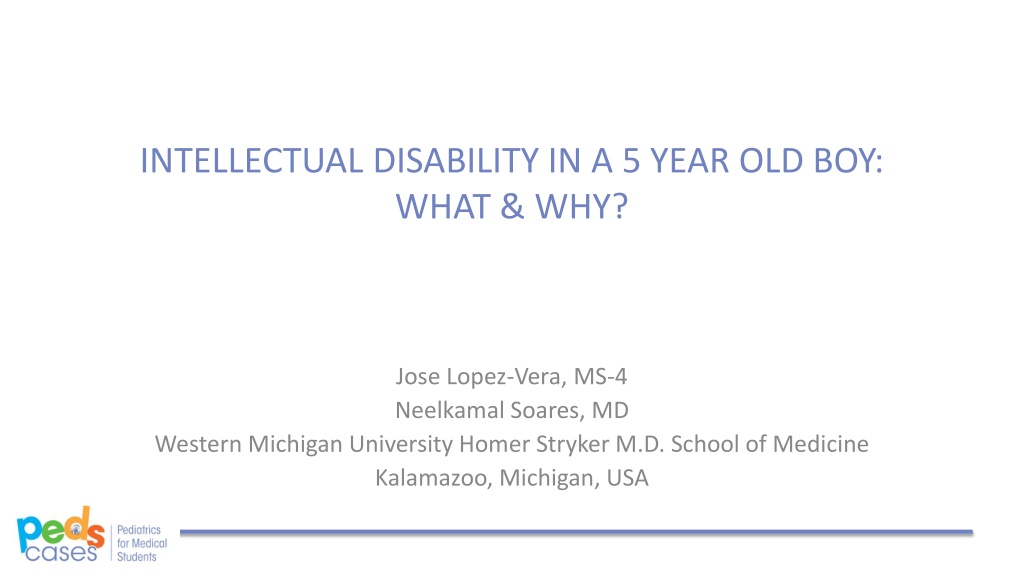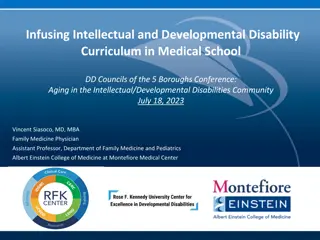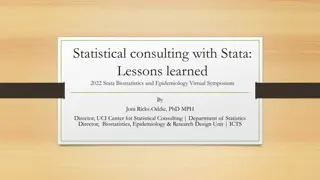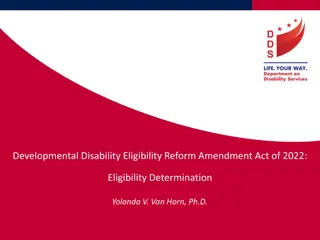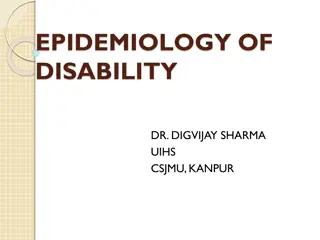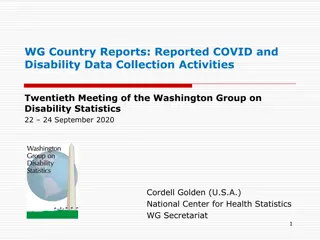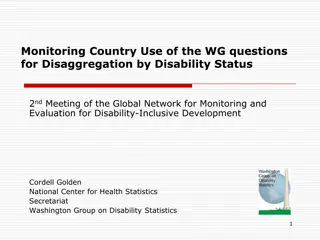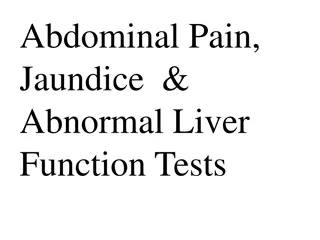Intellectual Disability in a 5-Year-Old Boy
This case study discusses the diagnosis and severity of intellectual disability (ID) in a 5-year-old boy, distinguishing between developmental delay and ID. It covers the importance of genetic testing, particularly in cases like Fragile X syndrome, as well as the evolution of assessing ID severity beyond IQ scores. The case highlights the need for early identification and appropriate support for children with intellectual disabilities.
Download Presentation

Please find below an Image/Link to download the presentation.
The content on the website is provided AS IS for your information and personal use only. It may not be sold, licensed, or shared on other websites without obtaining consent from the author. Download presentation by click this link. If you encounter any issues during the download, it is possible that the publisher has removed the file from their server.
E N D
Presentation Transcript
INTELLECTUAL DISABILITY IN A 5 YEAR OLD BOY: WHAT & WHY? Jose Lopez-Vera, MS-4 Neelkamal Soares, MD Western Michigan University Homer Stryker M.D. School of Medicine Kalamazoo, Michigan, USA
OBJECTIVES After this podcast/discussion, the learner will be able to: Distinguish between developmental delay (DD) and intellectual disability (ID) Articulate the rationale for genetic testing in children with DD or ID Discuss some of the findings in patients with fragile X syndrome
THE CASE 5 year old boy School physical visit to primary pediatrician He has no current illness or concerns. Family history is unremarkable, he is the only child, raised by single mother, little information about father. His physical exam is unremarkable
THE CASE CONTINUED Past records available: History of developmental delay at age 4 Referred for educational testing to local school district intellectual impairment , intelligence quotient (IQ) score of 61, and adaptive score of 63 on school testing Neurologist evaluation with lab testing Negative chromosomal microarray Fragile X molecular test 240 CGG repeats
SEVERITY OF ID In the past, severity of ID was based on the IQ scores Mild (52-69) Moderate (36-51) Severe (20-35) Profound (19 or below) However, IQ scores are not reliable as they get lower, adaptive functioning is more realistic Severity is now based on the 3 domains (practical, conceptual and social) and how an individual functions and what degree of supports he/she needs
FIRST THINGS FIRST. DIAGNOSIS? Intellectual disability (ID): significant limitations both in intellectual functioning and adaptive behavior as expressed in conceptual, social, and practical adaptive skills, that originates before the age of 18. (American Association on Intellectual and Developmental Disabilities (AAIDD), 2010) Mental retardation is the archaic term (pre-2007), when the AAIDD substituted it with ID.
HOW IS DEVELOPMENTAL DELAY DIFFERENT? Global developmental delay (GDD): failure to attain expected developmental milestones in 2 or more areas of functioning ID is usually identified later than GDD (after age 5), and is usually chronic in nature. GDD is diagnosed when children are too young or too impaired to undergo systematic assessment of various levels of functioning Not all children with GDD are found later to have ID
SO WHAT ARE THE CRITERIA FOR ID? Diagnostic criteria from the Diagnostic & Statistical Manual of Mental Disorders, 5thedition (DSM-5) is used by clinicians and researchers across North America. Intellectual Developmental Disorders and Intellectual Disability (ID) are used synonymously. The diagnostic criteria are: Deficits in intellectual function Deficits in adaptive functioning that result in failure to meet developmental and sociocultural standards for personal independence and social responsibility. Onset of intellectual and adaptive deficits during the developmental period.
WHO CAN DIAGNOSE ID? Professionals who either conduct or review standardized evaluations of intelligence and adaptive functioning Physicians (primary or subspecialists) may identify deficits in adaptive functioning Psychologists (clinical, educational, neuropsychologists) generally conduct intelligence assessment, and also conduct adaptive assessment Should not be diagnosed based on opinion or non-standardized testing or history of delays Often, diagnosis will be revisited after a period of time (~ 2-3 years) to ensure the individual still meets criteria Educational qualification of ID and medical diagnosis of ID may not be concordant as different systems use different nomenclature and criteria
WHAT IS FRAGILE X SYNDROME? Most common inherited form of intellectual disability 1 in 4000 males, 1 in 6000 females 1 in 151 females and 1 in 468 males are carriers of the premutation Causes intellectual disability, behavioral and learning challenges, and various physical characteristics.
PHYSICAL CHARACTERISTICS Physical features vary from patient to patient. Often, features are not obvious when younger, and become more pronounced in adolescence. Physical features include: Facial: Large ears, Long face. Prominent jaw Connective tissue: flat feet, high arched palate, double jointed fingers and hyper-flexible joints Strabismus Low muscle tone Macro-orchidism (post-pubertal) Photo used with permission from Paula Fasciano
COMORBIDITIES NEUROPSYCHIATRIC Attention Deficit/Hyperactivity Disorder Autism Spectrum Disorder Social Anxiety Disorder Sensory Integration Difficulties Intellectual Disability Repetitive behaviors (hand flapping) Self-injury, aggression MEDICAL Gastroesophageal Reflux Disease Obstructive Sleep Apnea Recurrent sinusitis/otitis media Decreased visual acuity Scoliosis Mitral Valve Prolapse
HOW IS FRAGILE X TESTED? Southern blot and PCR technologies look for a trinucleotide repeat (CGG) in the FMR1 gene. The FMR1 gene encodes the fragile X mental retardation protein (FMRP), which is a regulatory protein that binds mRNA in neurons and dendrites. In a full mutation, FMRP is not made due to hypermethylation of FMR1, brain development is impaired due to abnormal synapse connections. It also can lead to excessive activity of the metabotropic glutamate receptor 5 (mGluR5) which results in many fragile X symptoms in other tissues. Karyotype not performed anymore
GENETIC PRESENTATIONS OF FRAGILE X Gene Reviews 2012
SO WHY DO GENETIC TESTING IN ID? Advances in testing technology have increased the diagnostic yield of genetic etiology for ID or GDD from 6 10% a few years ago to 30 40%. Recommended tests by American Academy of Pediatrics and American College of Medical Genetics include chromosomal microarray (CMA) DNA probe for fragile X. Proposed benefits improved patient and family education of diagnosis and expected clinical course refining treatment and avoiding unnecessary tests Genetic tests are for establishing diagnosis, not confirming a clinical diagnosis.
OTHER TRINUCLEOTIDE REPEAT DISORDERS Huntington s Disease - CAG Friedreich s Ataxia - GAA Myotonic dystrophy - CTG Spinocerebellar ataxia - CAG Spinal and bulbar muscular atrophy (SBMA) - CAG and several others
COMORBIDITIES NEUROPSYCHIATRIC Attention Deficit/Hyperactivity Disorder Autism Spectrum Disorder Social Anxiety Disorder Sensory Integration Difficulties Intellectual Disability Repetitive behaviors (hand flapping) Self-injury, aggression MEDICAL Gastroesophageal Reflux Disease Obstructive Sleep Apnea Recurrent sinusitis/otitis media Decreased visual acuity Scoliosis Mitral Valve Prolapse
LATE COMPLICATIONS OF FRAGILE X Fragile X Associated Tremor/Ataxia Syndrome (FXTAS) premutation in FMR1 and white matter lesions on MRI in middle cerebellar peduncles and/or brain stem with intention tremor or gait ataxia. FMR1 Related Primary Ovarian Insufficiency (FXPOI) cessation of menses before age 40 years in a woman with FMR1 premutation.
INTERPROFESSIONAL APPROACH Frag X has no cure Some emerging targeted therapies, but so far clinical trials either underway or inconclusive Supportive treatment addresses the medical and neuropsychiatric comorbidities, educational and rehabilitative therapies and genetic counseling Pharmacist Primary Clinicians Specialists Healthcare Physical and Counselor Occupational Therapy Child & Family Mental Health Rehabilitation Speech Psychiatrist Therapy School Support Educators Staff
TAKE HOME POINTS The term Mental retardation is archaic, now replaced with intellectual disability (ID) Global developmental delay (GDD) is the term used most often in younger children (and with less severity) Genetic testing is indicated in searching for diagnosis in ID and GDD Fragile X syndrome is the most common inherited cause of ID Fragile X has many disease manifestations: physical, cognitive, psychosocial An interprofessional approach is often required in the care of individuals with fragile X syndrome.
REFERENCES Saul RA, Tarleton JC. FMR1-Related Disorders. [Updated 2012 Apr 26]. In: Adam MP, Ardinger HH, Pagon RA, et al., editors. GeneReviews [Internet]. Seattle (WA): University of Washington, Seattle; 1993-2018. Available from: https://www.ncbi.nlm.nih.gov/books/NBK1384/ FXS National Fragile X Foundation. Retrieved March 28, 2018, from https://fragilex.org/learn/ Home | Fragile X Syndrome (FXS) | NCBDDD | CDC. Retrieved March 28, 2018, from https://www.cdc.gov/ncbddd/fxs/index.html Hersh JH, Saul RA, Committee on Genetics. Health Supervision for Children With Fragile X Syndrome Pediatrics May 2011, 127 (5) 994-1006
